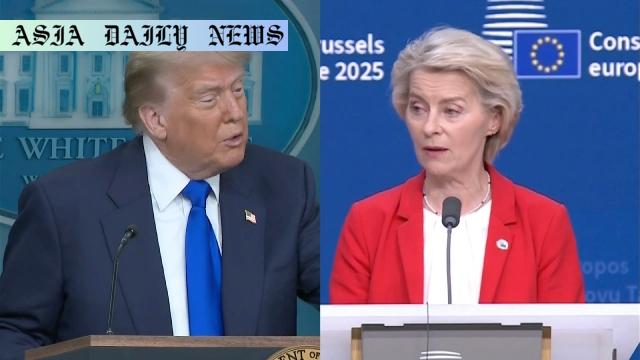Tariff – US President Donald Trump to impose a 30% tariff on European Union and Mexican imports starting August 1.
- Trump announces a 30% tariff on imports from EU and Mexico.
- The tariff will be implemented starting August 1.
- Mexico’s border efforts insufficient according to Trump.
- Certain exemptions under free trade agreements remain unclear.
- EU continues trade deal negotiations, focusing on aviation and automobiles.

Introduction: New Tariffs and Trade Relations
On August 1, 2023, US President Donald Trump will enact a 30% tariff on products from both the European Union and Mexico. This development marks a significant escalation in America’s trade policies and reflects Trump’s approach to reposition the United States in global commerce. The announcement came via letters posted on social media, where Trump detailed his intent and reasoning for the policy shift. This action follows months of strained negotiations and previous tariff adjustments, signaling a key moment for international trade dynamics.
Trump’s Reciprocal Tax And EU Negotiations
The 30% tariff is an evolution of Trump’s earlier announcements regarding “reciprocal taxes.” In April 2023, he proposed a 20% tariff on the EU, citing disparities in trade policies. By May, as negotiations reached a stalemate, he even indicated a potential rise to 50%. Although EU officials have been actively focusing on resolving key issues, particularly in the aviation and automobile sectors, Trump’s decision to impose tariffs suggests growing frustration over their progress.
Notably, EU and US officials have been in talks to address several core challenges relating to market access and fairness in competition. An unnamed EU trade negotiator recently expressed optimism about concluding a mutually beneficial agreement. However, this tariff introduces new complexities that could hinder such developments. In essence, the unilateral decision could jeopardize collaborative progress.
Mexico, Trade, And The Border Issue
The situation with Mexico has a contrasting but connected rationale. For months, Trump has maintained a 25% import tax on Mexican goods, attributing this to increasing flows of fentanyl entering the US. While applauding Mexico’s efforts to secure the border, he deemed them inadequate in his latest correspondence. As a result, a higher tariff rate of 30% will now apply.
However, the precise implementation of this tariff remains unclear, particularly regarding goods that fall under the free trade agreement with Canada and Mexico. The United States-Mexico-Canada Agreement (USMCA) is designed to facilitate trade and promote economic cooperation across these nations, and Trump’s letter lacks clarification on whether the new rates will exclude covered goods.
Implications For Future Trade And Relations
These new tariffs underscore several critical issues. Firstly, they bring the potential for reciprocal actions from affected countries, which could escalate into broader trade conflicts. Secondly, these moves could impact consumer pricing within the US, as tariffs are typically transferred to end-users through price increases. Lastly, this development reaffirms Trump’s broader economic agenda, which frequently prioritizes domestic interests over international collaboration.
Economists predict that these changes could prompt re-negotiations, affecting multiple industries, including manufacturing, agriculture, and high-value sectors like aviation. Moreover, the lack of a clear structure for exemptions suggests prolonged discussions may be necessary. This strategy showcases Trump’s commitment to leveraging tariffs as a negotiation tool despite potential consequences to diplomatic and economic ties globally.
Conclusion
In conclusion, the 30% tariff on imports from the European Union and Mexico represents a critical milestone in the increasingly complex sphere of international trade policy under Trump’s administration. As these changes take effect, their long-term implications will depend on whether global counterparts respond with retaliatory measures or engage in renewed negotiations. Either way, the global trade landscape is evolving rapidly, and stakeholders across all industries must strategically prepare for ongoing shifts.



Commentary
Trump’s Trade War: A Strategic or Risky Move?
The imposition of a 30% tariff on imports from the European Union and Mexico has raised significant questions about President Donald Trump’s trade strategy. Is this move a calculated step to strengthen domestic industries, or could it backfire, leading to unforeseen economic and diplomatic repercussions? As we delve into the details, the benefits and risks of this bold decision demand careful examination.
Domestic Gains Versus Global Retaliation
From a domestic standpoint, Trump’s approach of leveraging tariffs aims to protect American businesses, discourage importing cheaper foreign goods, and encourage local manufacturing. In theory, this bolsters the nation’s economy and secures jobs. However, the global market rarely operates in isolation. A move this aggressive risks retaliatory tariffs from other nations, which could adversely affect American exporters. For example, previous tariff hikes led European countries and China to impose their countermeasures, targeting US agricultural and manufacturing goods.
The Uncertainty of International Agreements
While tariffs are an effective short-term tool, they create uncertainty around long-term trade partnerships. The 30% tariff sends a message that the United States is serious about balancing what it perceives as unfair trade practices. However, in doing so, it risks alienating allies and fostering mistrust. Notably, the lack of clarity surrounding exemptions under existing agreements like the USMCA makes it harder for businesses to plan and adjust. This uncertainty is the kind of unpredictability that economies dread.
Conclusion: Proceeding With Caution
While Trump’s decision appeals to his base, particularly those who advocate a “Buy American” mentality, it is not without risks. These tariffs may achieve desired immediate effects—perhaps enticing trade partners to renegotiate terms—but the broader economic and diplomatic ramifications could be long-lasting. Striking the right balance between protecting national interests and fostering international goodwill remains a delicate and complicated task. Only time will reveal whether this move will be remembered as a masterstroke or a misstep.